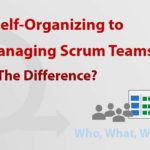Projects have always been a complex endeavor and have always to deal with the unpredictable, the surprising, and the unexpected. This was 200 years ago so, and it is still so. However, the complexity is increasing every year, especially when IT technologies are involved. In this environment, it’s harder to predict what will happen because […]
Author Archive: RolandWanner
How to Reduce Risks in Product Development
Companies that develop products often take considerable risks that can, for example, jeopardize the continued existence of the company. Developing innovative products in particular is a risky and uncertain process and many products fail, for example, due to feasibility or market acceptance. This uncertainty often leads companies to avoid taking risks—and if they do, they […]
How to Control Agile Projects – Monitoring and Control
You may wonder why project control is not a topic in agile projects. Even the well-known Scrum Guide does not mention this term. But I can already tell you that project control is also carried out in agile projects. Project control for agile projects is somewhat different from “normal” projects, because the Scrum team is […]
Do You Know the Difference Between Risk Appetite, Risk Tolerance and Risk Threshold?
If you deal with risk management in projects or in the company, then sooner or later you will encounter the terms Risk Attitude, Risk Appetite, Risk Tolerance and Risk Threshold. Do you know what we are talking about here? No? No problem, you won’t be alone. I’m sure this brief introduction will expand your knowledge. […]
How to Use the Milestone Trend Analysis Successfully
In project control, there are various methods to monitor the project. In addition to the plan/target/actual comparison and earned value management, the milestone trend analysis (MTA) is one of the best-known methods for project monitoring. One of the main goals of the milestone trend analysis is to monitor the progress of the project in order […]
What is a Minimum Marketable Product in Agile Product Development?
When developing and launching a new product, you need to anticipate future trends and what customers will want in the coming months. However, very few of us can predict the future or conduct lengthy market and customer analyses. This is where Agile Product Development comes into play, applying concepts like the Minimum Viable Product (MVP) […]
From Self-Organizing to Self-Managing Scrum Teams – What’s The Difference?
The Scrum Guide 2020 introduced several changes. Most of them are well understandable, and their sense and benefit is clearly recognizable. However, one adaptation is not so easy to explain and the benefit is not necessarily obvious. Self-organizing has been replaced by self-managing. Do you know the difference between these two forms of organization? This […]
How to Successfully Conduct Sprint Planning in Scrum
Sprint Planning is one of the five Scrum Events. The Scrum Guide 2020 has expanded Sprint Planning by one topic and now addresses not only the “What” and the “How”, but now also the “Why”. This is an important addition that also places the focus on the product goal. Read on to learn more about […]
What Does Resilience Have to Do With Risk Management in Projects?
The term resilience is not used that often. New in the PMBOK© Guide 6th Edition it is represented in the chapter Risk Management as “Project Resilience”. Many of you will not know exactly what the PMBOK© Guide means. In this article I will show you what resilience means and specifically what it means for projects […]
Do You Really Know the Minimum Viable Product (MVP) in Agile Projects?
Curious about what really defines a Minimum Viable Product (MVP) in agile projects? Developing innovative products often comes with high risks, which can lead to project failures. In this context, using an MVP has shown to be a highly effective approach, especially in agile software development. Do you understand what an MVP is, why it’s […]










